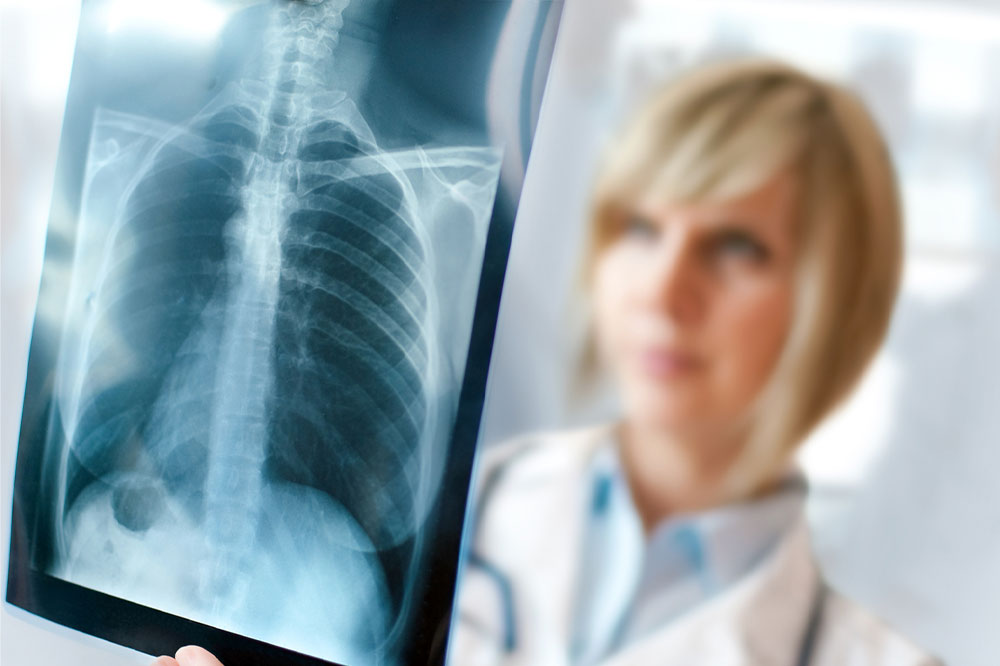Types and early signs of lung cancer

Lung cancer refers to cancerous growth beginning in one’s lungs and spreading to the other body parts. There are two major types of lung cancer – non-small cell lung cancer and small-cell lung cancer. As the condition progresses, cancer-causing cells may spread to other lymph nodes and body organs, including the brain, liver, adrenal glands, and bones. Early diagnosis and intervention are crucial for recovery. This article lists the types and early signs of lung cancer.
Types of lung cancer
Non-small cell lung cancer (NSCLC)
This is the most common type of lung cancer. Typically, this type of cancer develops under three conditions:
- Adenocarcinomas found in the lung’s outer region
- Squamous cell carcinomas found in the center of the lung
- Large-cell carcinomas found anywhere in the lung
Exposure to harmful substances like uranium, coal products, gasoline, mustard gas, and diesel exhaust can increase one’s risk of NSCLC.
Small-cell lung cancer (SCLC)
In this condition, malignant cells develop in one’s lung tissues. There are primarily two types of small-cell lung cancer – small-cell carcinoma (or oat cell cancer) and combined small-cell carcinoma. Chronic exposure to chromium, beryllium, soot, tar, etc., can increase one’s risk of SCLC. Radiation therapy performed in the breast to treat breast cancer can also increase one’s susceptibility to the condition.
Early signs of lung cancer
- Persistent cough
Lung cancer typically leads to persistent wet or dry coughs that last for more than three weeks at a stretch. Some individuals may also cough up blood due to bleeding in the air pathways. This condition is called hemoptysis and is often a sign of lung cancer. - Chest infections
Individuals with lung cancer have compromised immune systems, which increases their vulnerability to chest infections like pneumonia. Chest infection is the second most common cause of death among patients with lung cancer, next only to the growth of cancerous tumors. - Shortness of breath
Lung cancer may also lead to dyspnea or shortness of breath, as one’s lungs may not receive adequate oxygen levels. Shortness of breath may occur among patients with lung cancer after physical activity or even while at rest. - Fatigue
A weakened immune system and insufficient oxygen supply due to lung cancer may trigger extreme fatigue and lack of energy to perform even basic daily tasks. Chemotherapy and other treatments for lung cancer may aggravate this symptom. - Loss of appetite
Over 60% of patients with lung cancer experience loss of appetite, which causes them to shed several pounds. This typically occurs because cancerous tumors release substances that reduce one’s appetite and cause malnutrition. - Body pain
When cancer cells begin spreading to other body parts, one may experience pain in these areas. Bone pain, particularly in the hips and back, is a common sign of lung cancer. - Voice hoarseness
Patients with lung cancer may develop voice hoarseness due to damage caused to their vocal cords. - Yellowing of the skin
If lung cancer spreads to one’s liver, it may lead to jaundice symptoms, i.e., yellowing of the skin and eyes. - Swelling of the lymph nodes
Lung cancer may spread to lymph nodes around the lungs and in the chest, causing swelling of these nodes. - Swollen face
Lung cancer may cause swelling of the face if the malignant tumors in one’s lungs block the flow of blood to the face. This symptom is referred to as superior vena cava syndrome (SVCS). - Finger clubbing
Finger clubbing occurs when one’s nails soften, and the skin next to one’s nail bed becomes tender, followed by swelling of the fingertips. This symptom is observed among 35% of individuals with NSCLC and 4% of those with SCLC. - Headache
Headaches may be caused among patients with lung cancer following the spread of cancer to the head and the development of a tumor near the superior vena cava, a vein that supplies blood from the head to the arms and the heart. - Horner syndrome
Lung cancer may sometimes spread to the nerves and cause nerve damage, leading to symptoms like nerve pain or neuropathy. Such nerve damage may cause Horner syndrome, a disease affecting one side of the face and leading to drooping of the eyelids. - Arm and shoulder pain
In some rare cases of lung cancer, called Pancoast tumor, the cancerous tumor grows in the upper part of the lungs. In such cases, patients may experience severe arm and shoulder pain, which can sometimes spread to the upper back and arms. - Loss of balance
As mentioned before, lung cancer may cause the development of a tumor in the superior vena cava, which can lead to loss of balance and control over body movements. - Anemia
Anemia, or lack of hemoglobin in the blood, is another symptom of lung cancer. Anemia is typically caused by loss of appetite due to the condition but may also be triggered by the spread of cancer to other organs, such as the bone marrow. Cancer-related interventions may further cause low iron levels in the blood. - Digestive conditions
In some cases, individuals with lung cancer may develop hypercalcemia, a condition associated with increased levels of calcium in the body. Consequently, they may face digestive problems like constipation, nausea, and abdominal pain. - Frequent urination
Hypercalcemia due to lung cancer may also cause other symptoms like frequent urination and extreme, unquenchable thirst.
Early diagnosis of lung cancer is crucial to ensure steady recovery from the condition. Doctors may diagnose the disease with the help of X-rays and some other diagnostic tests. In addition, while healing from lung cancer, individuals should implement certain lifestyle and nutritional changes. For example, it is recommended to have antioxidant-rich foods, such as dark-green vegetables, berries, oatmeal, and fatty fish. One should also strictly avoid exposure to chemicals like gasoline and mustard gas, which can trigger or worsen lung cancer. One should also seek assistance for daily tasks from family members, friends, and professionals, as lung cancer treatment can cause extreme fatigue.







